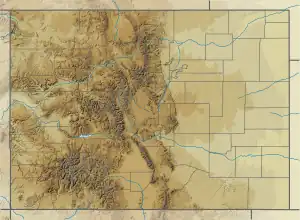Williams Fork Formation
The Williams Fork Formation is a Campanian (Edmontonian) geologic formation of the Mesaverde Group in Colorado. Dinosaur remains are among the fossils that have been recovered from the formation, most notably Pentaceratops sternbergii,[1]. Other fossils found in the formation are the ammonite Lewyites, neosuchian crocodylomorphs, and the mammals Glasbius and Meniscoessus collomensis.[2][3]
| Williams Fork Formation | |
|---|---|
| Stratigraphic range: Campanian (Edmontonian) ~ | |
| Type | Geological formation |
| Unit of | Mesaverde Group |
| Lithology | |
| Primary | Mudstone |
| Other | Sandstone |
| Location | |
| Coordinates | 40.0°N 108.8°W |
| Approximate paleocoordinates | 47.5°N 80.3°W |
| Region | Colorado |
| Country | |
 Williams Fork Formation (the United States)  Williams Fork Formation (Colorado) | |
See also
References
- Diem, Steve; Archibald, James D. (2005). "Range extension of southern chasmosaurine Ceratopsian dinosaurs into northwestern Colorado". Journal of Paleontology. 79 (2): 251–258. CiteSeerX 10.1.1.538.7263. doi:10.1666/0022-3360(2005)079<0251:REOSCC>2.0.CO;2. S2CID 17715685. Retrieved 21 September 2016.
- Jubb Creek at Fossilworks.org
- Rangely South (SDNHM) at Fossilworks.org
Bibliography
- Weishampel, David B.; Peter Dodson, and Halszka Osmólska (eds.). 2004. The Dinosauria, 2nd edition, 1–880. Berkeley: University of California Press. Accessed 2019-02-21. ISBN 0-520-24209-2
Further reading
- J. R. Foster and R. K. Hunt-Foster. 2015. First report of a giant neosuchian (Crocodyliformes) in the Williams Fork Formation (Upper Cretaceous: Campanian) of Colorado. Cretaceous Research 55:66-73
- W. J. Kennedy, W. A. Cobban, and G. R. Scott. 2000. Heteromorph ammonites from the Upper Campanian (Upper Cretaceous) Baculites cuneatus and Baculites reesidei zones of the Pierre Shale in Colorado, USA. Acta Geologica Polonica 50:1-20
- J. A. Lillegraven. 1987. Stratigraphic and evolutionary implications of a new species of Meniscoessus (Multituberculata, Mammalia) from the Upper Cretaceous Williams Fork Formation, Moffat County, Colorado. Dakoterra 3:46-56
- Sullivan, R.M., and Lucas, S.G. 2006. "The Kirtlandian land-vertebrate "age" – faunal composition, temporal position and biostratigraphic correlation in the nonmarine Upper Cretaceous of western North America." New Mexico Museum of Natural History and Science, Bulletin 35:7-29.
This article is issued from Wikipedia. The text is licensed under Creative Commons - Attribution - Sharealike. Additional terms may apply for the media files.